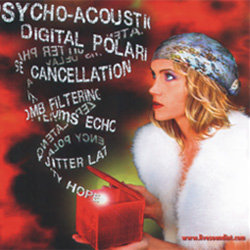
.
I’d venture that without this evidence, the general consensus would have been that less latency would always produce less comb effect and always be preferable.
But a comparison of the waveforms from this section shows that the notches are fewer and wider at 1 ms.
It also occurs at frequencies that would affect the vocal range just as the latency at 5 ms or even 10 ms does.
In fact, if the comb filtering at 1 ms were producing unacceptable tone quality, a possible solution might be to actually add a few milliseconds of latency to shift the affected frequencies and move the notches closer together.
Reversing the polarity of the in-ear monitor signal can have more of an effect on how things sound than the amount of latency alone.
The upper section of Figure 6 shows the result of mixing a signal with 1 ms of latency that is opposite polarity from the original compared to the non-inverted. Note that the peaks and valleys have swapped positions.

Figure 7 provides a comparison of 1 ms, 5 ms, and 10 ms latencies with the inverted result in the upper section. It’s also important to note that not all headphone manufacturers construct their headphones with the same polarity.
If equalization for monitoring is set up with a particular brand of headphone and then, instead, a different brand that is opposite in polarity is used, the frequency response can change significantly.
THE OCCLUSION EFFECT
An occlusion effect occurs when some object (like an un-vented ear mold) completely fills the outer portion of the ear canal. What this does is trap the bone-conducted sound vibrations of a person’s own voice in the space between the ear mold and the eardrum.
Ordinarily, when people talk (or chew), these vibrations escape through an open ear canal. But when the ear canal is blocked by an ear mold, the vibrations are reflected back toward the eardrum and increase the loudness perception of the person’s own voice.
Compared to a completely open ear canal, the occlusion effect may boost the low frequency (usually below 500 Hz) sound pressure in the ear canal by 20 dB or more.

